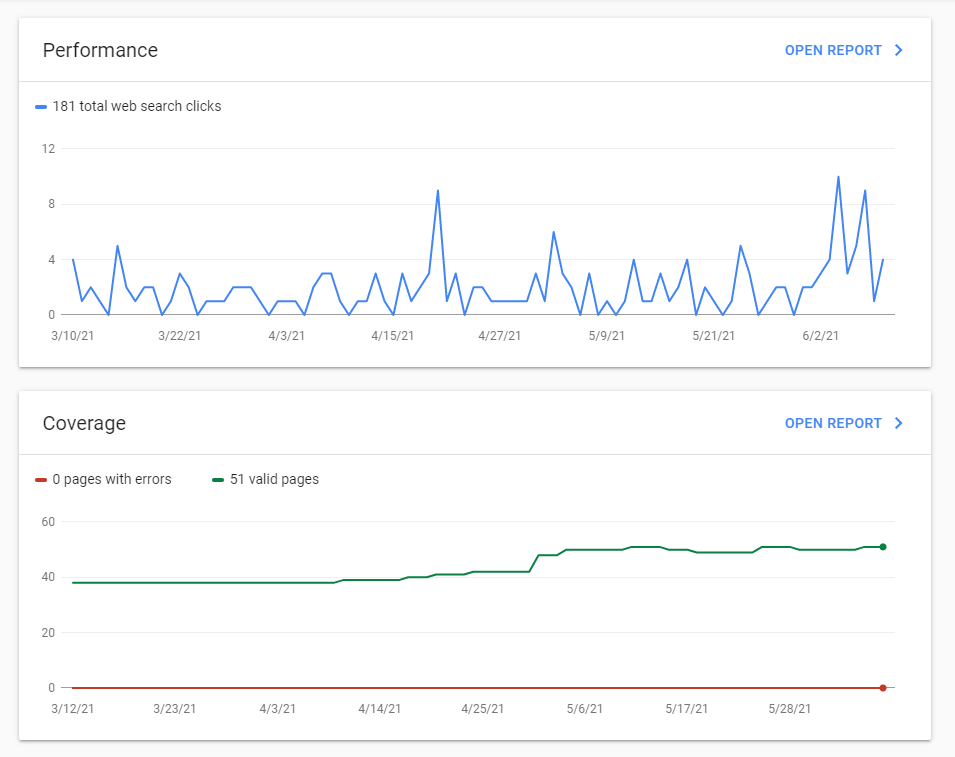
You’re working on a new website? How exciting! I bet you can’t wait for everyone to see it once it’s done.
…But what if no one can find it?
A lot of small business owners assume that building or hiring someone to build a “new” website for them will automatically mean increased traffic. Unfortunately, I’ve seen time and time again through my SEO consulting that that’s not the case.
Your new website will only attract more traffic from search engines if you plan your site architecture and content carefully with people and search engines in mind.
Here are 11 actionable SEO tips to follow when building your brand new website.
1. Don’t ditch your old site (yet)
If this isn’t your first website, it can be tempting to throw your last website straight in the garbage. Out with the old, in with the new!
But it’s likely your old website has something valuable worth saving.
When creating a new website, your old website has value for a few reasons:
- Domain age – Older domains tend to rank better on search engines
- Content – Content takes a long time to create, so don’t scrap it
- Backlinks – Existing links to your website from third-party sites boost your SEO
If you’re moving your website to a new domain name (i.e. you’re changing your website’s URL), be sure to implement a domain-level 301 redirect from your old website to your new website. This means that anyone who visits your old URL will automatically be forwarded to your new URL.
This is what that looks like in action:
youroldwebsite.com -> domain-level 301 redirect -> yournewwebsite.com
It’s recommended to keep your URL the same if you can to avoid having to create a 301 redirect. But that’s not always possible. For example, changing your business name may require a new domain name.
If you are staying on the same domain name but simply upgrading the design, you still have to make sure you don’t introduce any broken links. For example, removing a page or changing a page’s URL can create a 404 error if someone visits a link to your old page.
Therefore, try to keep as many of the same pages and URLs as you can. If you do change a page’s URL on your new website, you will need to create a page-level 301 redirect.
yourwebsite.com/oldpage –> page-level 301 redirect –> yourwebsite.com/newpage
Okay, let’s move on to the fun part, creating your new website!
2. Choose an SEO-friendly domain name
If you’re starting a new website from scratch, you’ll have to buy a domain name (your website’s URL).
It used to be the case that keyword-rich URLs carried more value. For example, if you were a photographer named Jane Doe in Austin, austinphotographer.com would be more likely to get you traffic than a URL like janedoephotography.com.
However, that’s no longer the case. If a URL has never hosted a website before, then the URL itself doesn’t carry any inherent SEO value.
Choosing an SEO-friendly URL is more about picking a URL that seems trustworthy, reflects your business, and is attractive enough to click.
Here are a few tips for picking your domain name:
- Name it after your business (if possible)
- Make it memorable
- Keep it short
- Don’t stuff it with keywords
- Make it easy to spell
- Buy .com if you can, as it’s what most people are familiar with (or your country’s ccTLD)
If you need tips on choosing a business name, check out this article.
3. Plan your target keywords
Before you even start planning your site’s content or pages, stop to brainstorm a list of keywords. Open up a document or spreadsheet and list every keyword you can think of that someone might search for to find your product or service.
Here are a few places to find keywords:
- Look through anything you’ve already written about your business: your social media bio, old website copy, a brochure, etc. If you say you’re a “stationery shop” offering “watercolor wedding invitations” and “custom birthday party invitations”, those are all good keywords.
- Look through websites for similar businesses. What have they named their pages, their services, and their products? You may see some phrases there that you hadn’t thought of.
- What do your customers ask you for? Pay attention to your customers’ own language to really understand the keywords they’d search for. For example, you may call your business a “bridal salon” but notice that customers usually say “wedding dress shop” instead.
What shows up under suggested or related searches on Google if you search for your main keywords? What shows up under “People also ask”?
Once you have a good list of keywords, highlight the most important ones. Which seem to be most relevant to what you do?
For extra credit, you can also use a free tool like SearchVolume.io to test which keywords are searched the most.
For example, a photographer’s partial keyword list might look like this:
- Greenville wedding photographer (*most important)
- Engagement photography
- Wedding photography
- Family photography
- Wedding photography prices
- Wedding photography packages
Save your list, because you’ll need it for the next step.
4. Plan your pages and keywords
The next step is to plan your site structure around your most important keywords.
The goal is to make sure that every keyword—or group of related keywords—is represented by a page, and that all pages have assigned keywords.
Start by writing a list of all the pages you know you need on your website:
- Home page – summarizes your business succinctly and has links to all important services
- About page – introduce yourself and why you do the work you do
- Service pages – one page per service you offer
- Contact page – where people contact you
- Blog – to write SEO-friendly blog articles!
Assign each keyword to a certain page—don’t just sprinkle the same keywords all over your site. The “sprinkling” technique doesn’t help Google understand which page to show in the search results for that keyword. This is known as keyword cannibalization.
You will likely want to optimize your home page for your most important keyword. We’ll discuss how to use those keywords in the next section.
If you offer multiple services or products, I recommend creating a separate page for each of them that targets a keyword for that service. In my photographer example, that would mean a page about “Engagement photography”, a page about “Wedding photography”, and a page about “Family photography”.
You may also find it’s worth creating extra pages and blogs for some of the other keywords you identified. For example, you could have a page or blog post about “wedding photography prices” or “wedding photography packages”.
At the end, you should have a clear mapping of keywords to pages.
5. Create a clear site architecture
It helps both your site visitors and search engines to better understand your website if your site has a clear architecture.
What makes a clear site architecture?
Readable URLS – Make each page’s URL descriptive, short, and easily readable. e.g. yourwebsite.com/wedding-photography/ is much more descriptive than yourwebsite.com/page123/.
Helpful menus – Your top navigation should feature links to the most important pages or sections of your website. But keep it simple. Too many links in your top navigation can create unnecessary clutter (and nobody likes clutter).
Clear internal linking structure – It should be easy to navigate between related pages. For example, each of your service pages should include a list of links to your other service pages.
6. Create content
Now that you have a plan for your pages and how they’ll be linked to one another, it’s time to start creating content!
Your website’s written content is extremely important. Not only does compelling copy make your website visitors more likely to contact you, but it’s also what Google uses to understand what your page is about.
Google can’t quite “read” your website like people can (yet), but Google has bots that crawl all the content on your website. These bots pay attention to how often you use keywords, how thoroughly you seem to cover a topic, whether you simply copied your content from elsewhere, and whether you use the types of keywords people typically use when people discuss that topic.
In other words, it’s important that your content is unique, keyword-rich, and high quality.
What SEO content is required for each page?
- Title tag: The page title that appears on Google and your visitor’s browser tab. This should be under 60 characters and feature your target keywords.
- Meta description: The preview sentence that appears on Google or social media when you share your page. This should be under 160 characters and feature your target keywords.
- Headings: Use keyword-rich headings that make the page easier to consume, tagged with <h1>, <h2>, and <h3> tags in a logical, nested order.
- Page content: Your page should have valuable, keyword-rich content
- Links: Include helpful internal and external links that help your site visitor
Notice that I’ve used the phrase “keyword rich” a lot. This doesn’t mean to jam pack your page with keywords. It means that your target keywords should be used reasonably throughout your page, wherever natural.
7. Use a mobile-friendly, conversion-focused design
Your goal for your website is to win business, isn’t it? So design your site to capture leads!
To ensure your website has a user-friendly design that makes people want to work with you, focus on the following:
- Page speed: Nobody likes a slow website. Resize and compress images so they don’t take forever to load. And avoid having resource-heavy content like videos that may take a while to load.
- Mobile responsive design: This is standard by now with website design, but make sure your site’s mobile experience is just as wonderful as its desktop experience.
- Visual hierarchy: Use images and design elements in a thoughtful way that guide visitors through your pages and website.
- Calls to action: Have a clear call to action on every page, with buttons that stand out from the rest of the design.
- Forms: Make sure your website’s forms are simple and easy to fill out.
These things will actually help your SEO too. Google is increasingly paying attention to user experience metrics like page speed and time on site.
8. Set up Google Analytics
It’s hard to make future improvements to your site if you don’t know what’s working and what’s not.
Before you take your website live, set up Google Analytics so that you can track your website’s traffic over time.
Google Analytics can show you helpful metrics like:
- Users: How many unique people visited your site
- Pageviews: How many times each page was viewed
- Bounce rate: How many people immediately exited your site after landing on a page
- Time on page: How long people spend on each page.

There’s all kinds of good stuff in there that will help you see which pages are performing well and which could use a little more SEO love.
9. Go live!
After you’ve thoroughly quality-checked and proofread your site on both desktop and mobile, it’s time to take it live.
Congratulations! But your work isn’t done yet…
10. Submit your website to Google Search Console
Now that your site is live, you want Google to know it exists.
Create a Google Search Console account and submit your website’s XML sitemap. This is a page on your website that lists…all of the pages on your website.
For most websites, your sitemap URL will be …/sitemap.xml.
Google Search Console will also give you helpful information like how many of your website pages have been indexed in their search results, how many impressions your pages are getting in search results, and how many clicks you’ve received.

11. Build citations and backlinks
Outside of content, the biggest search engine ranking factor is backlinks. Backlinks are links to your website from other websites.
Why do backlinks matter? Think of them like little votes of confidence. Google assumes that good sites are more likely to have links to them than bad sites.
It’s not just about the quantity of backlinks though. Over time, Google has introduced backlink quality into the equation as well. So you can’t just have lots of backlinks. You need backlinks from relevant, high-quality sites.
So how can you build backlinks to your site? The best place to start is by building citations. These are typically free business directories that link to local businesses. Think of sites like Yelp and Google My Business. There may be other relevant sites in your industry that allow free listings.
Then, over time, do your best to earn backlinks from high-authority websites. Create high-quality content that people want to link to. Ask other local businesses to link to your website. But don’t do anything spammy! Google can find you…
Keep up with SEO
SEO makes the biggest impact when optimization is started at the very beginning of a website project, not after it’s done. So you’re already off to a great start.
But keep at it over time. Write more content, build more backlinks, and keep up-to-date on best SEO practices, as they’re evolving constantly!



